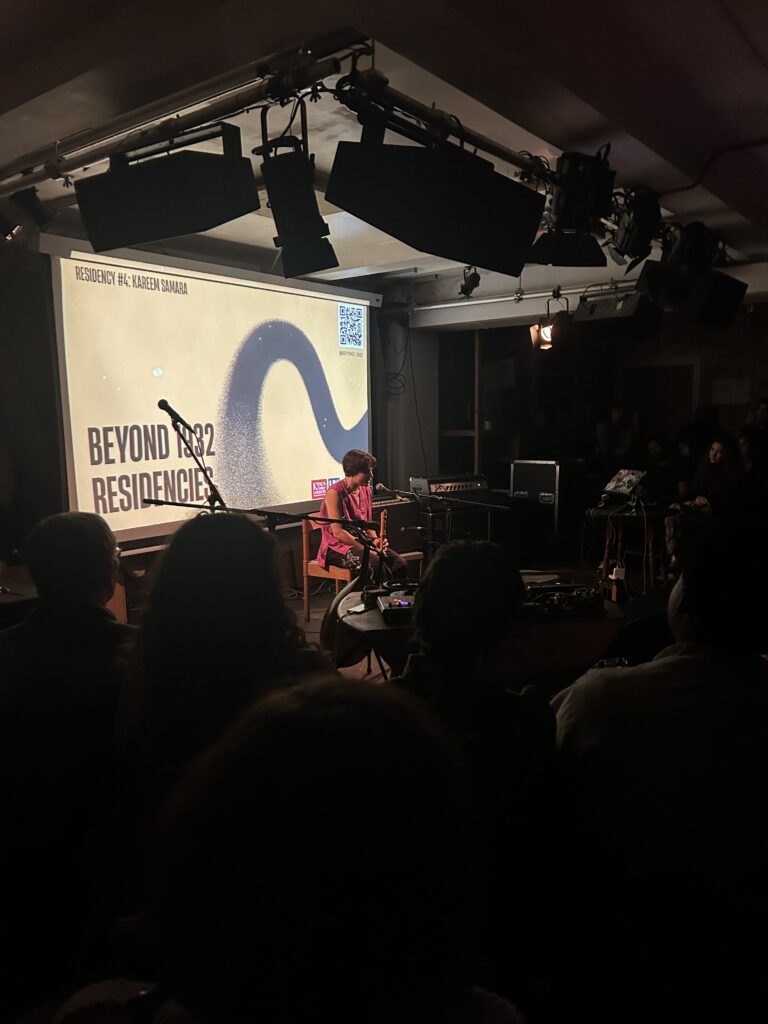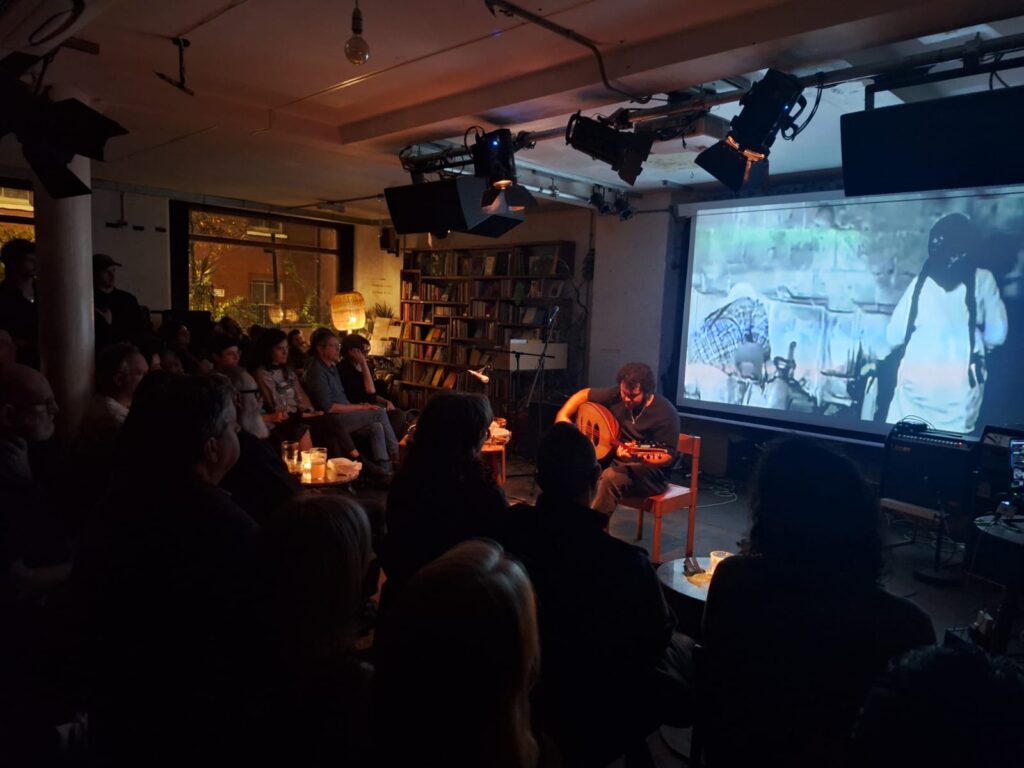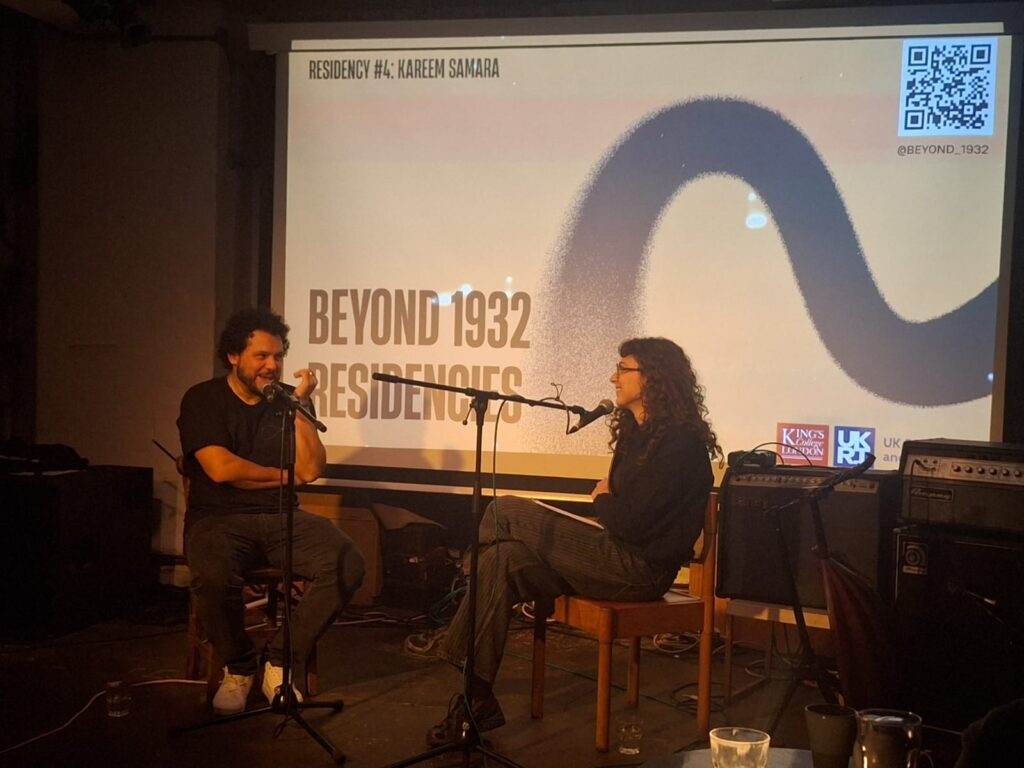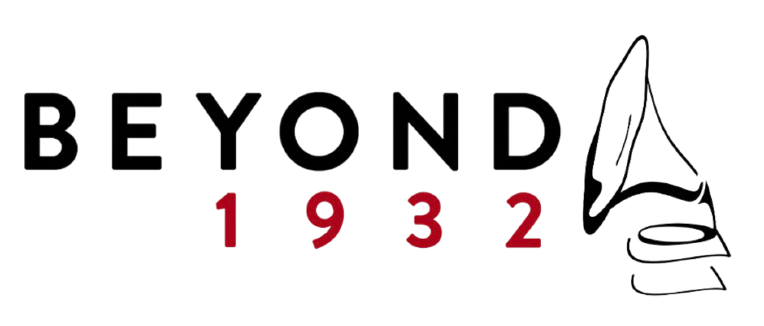The fourth edition of the Beyond 1932 artist residency series, organised by Rim Irscheid, cast the spotlight on Kareem Samara: a composer, improviser, and multi-instrumentalist based in London. I arrived at Café OTO, one of London’s prime venues for experimental and underground music, just after 7:30pm when doors opened and the queue stretched down the road which I took as a good sign! Once everyone had made their way into the venue, people started settling around the performance space on chairs, benches, the floor, or stood to enjoy the show and it was indeed a full house.
As the lights went down, the evening began with a brief introduction by Rim, the curator for the Beyond 1932 residency series. She spoke more about the research project before introducing the opening set for the night: an enchanting vocal / recorder set by Fatima Lahham, a musician, facilitator, and researcher based in London. Fatima captured the attention of the room with a powerful improvisatory performance: moving from sung Arabic lyrics, to playing the recorder, and then integrating both vocals and recorder playing in one breath. This performance was the perfect choice to precede Kareem; Fatima set the tone of the evening, preparing the audience for an event that was emotionally moving as well as culturally poignant.

After a 10-minute break, the audience members gathered around the performance space again as Kareem Samara made his way to the front of the room. Accompanied by live visuals from London-based visual artist L’Aubaine, Kareem opened his performance with what can be perceived as a traditional taqsim, or improvisation, on the Oud. He moved through the maqamat seamlessly, gradually expanding the range as the improvisation progressed. This sonic and visual experience captivated audience members, arguably, in a state of tarab. The aesthetic notion of Arab music associated with emotionality, enchantment, ecstasy, and transcendence.
However, this was not a traditional Oud taqsim, and Kareem’s performance space featured several guitar pedals to use with his plug-in Oud as well as a table full of percussion instruments and sample pads. To contrast the traditionally inspired and melodic opening of his performance, Kareem integrated live percussion, with a more frantic approach, while other musical ideas and vocal samples looped in the background. The percussive elements ranged from a more upbeat tambourine part to roughly punching down onto the sample and drum pads, demonstrating elements of frustration and anger in his performance.

Kareem also included an alternate approach to performance with the Oud which was fitting in this context. The use of pedals altered the warm sound of the Oud as Kareem experimented with various timbres and inputs. At one point he put a drum stick of some kind between the neck and the strings of his Oud and played around with the portamento-esque effect it created when he moved the stick to different angles and strummed at different places on the neck. Additionally, he would sometimes handle the Oud with less care, picking it up and putting it down with more force than usual. All of these experimental approaches to Oud performance can be read as a departure from the rigidity of traditional Arab music-making. They are an effort to engage with an instrument intimately, but authentically to the performer’s feelings in that moment.
The evening came to a close with a conversation between Kareem and Rim. Questions were opened to the audience and between us all we spoke about Kareem’s musical influences, the significance of politics in times of cultural erasure, understandings of “traditional” music, his relationship with the Oud he had performed with that evening, and much more. There was a sense that there was definitely more to be said despite the event coming to an end, but the conversations only continued after the performance and will continue so long as we keep having them, particularly in the interest of cultural preservation.

Kareem and I once had a conversation about tarab and saltana and their roles in contemporary Arab music. As a performer, he stated his belief in the importance of being in it: committing yourself to your performance, reaching saltana, and gaining the ability to create a performance atmosphere where you can express this emotionality to your audience. I feel as though Kareem succeeded that evening; we in the audience observed his immersion in his own performance and this was reflected onto us. We felt what he was feeling from joy, to anger, to ecstasy, to frustration, to pain, and everything in between. Tarab is typically affiliated with joy, but the sense of heightened emotionality in the room that night can only be described as a contemporary manifestation of tarab.
Tamara Batty is a PhD Music candidate at the University of Birmingham under the supervision of Dr Luis-Manuel Garcia-Mispireta. Her ethnomusicological research focuses on tarab and how artists and audiences engage with the traditional aesthetic notion in electronic music scenes across north-western Europe. Contact: tfb786@student.bham.ac.uk

